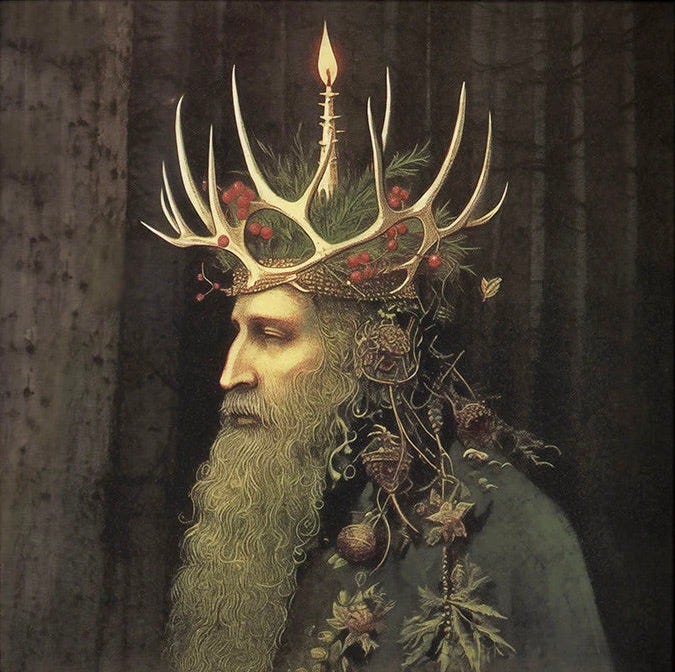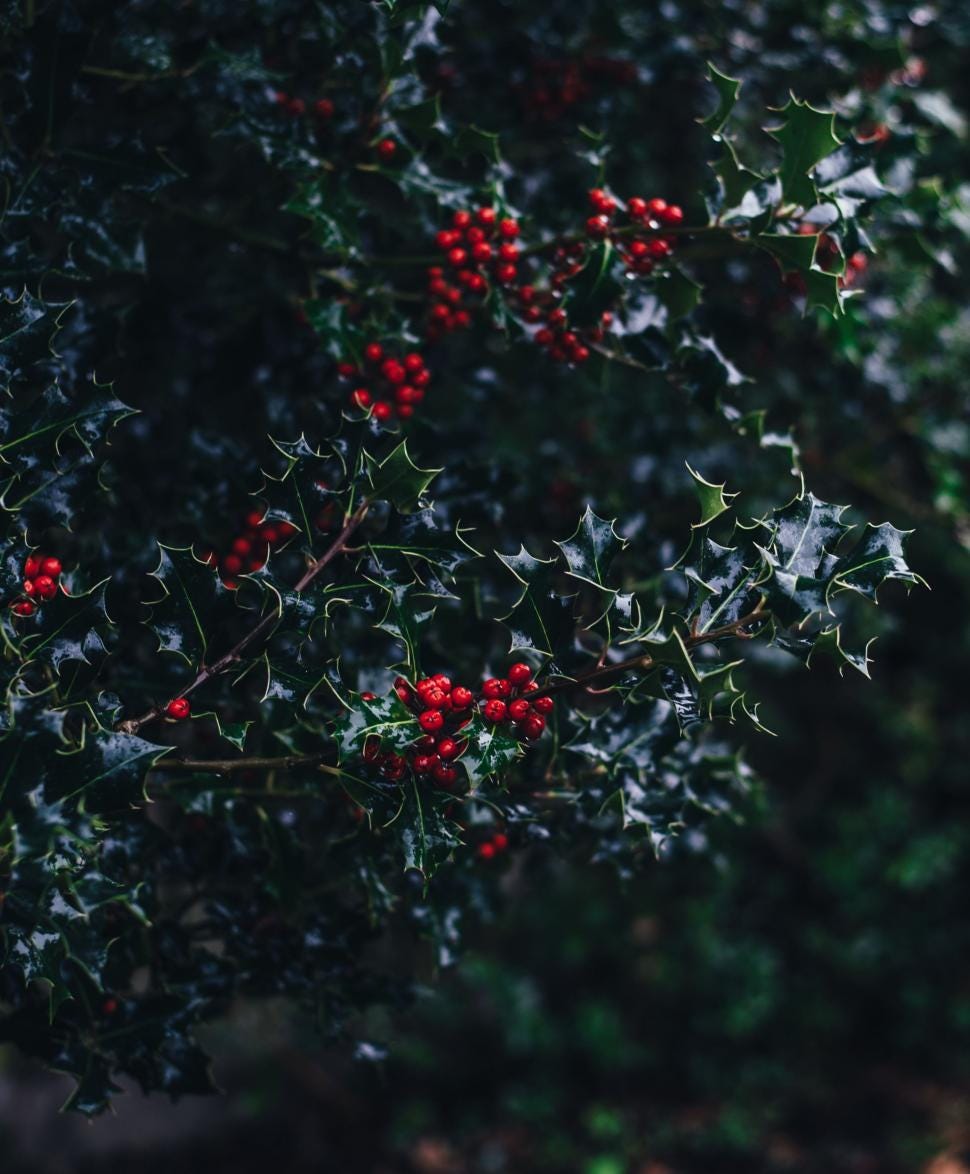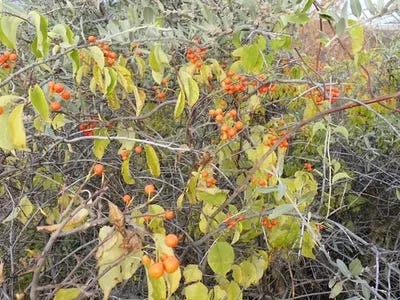ALSO KNOWN AS: Ilex aquifolium, Christmas holly, European holly, English holly
how to know
an evergreen shrub no more than 13 feet tall
broad glossy leaves with sharp points
berries on some
small white flowers in the spring
Witches and fairies dance on the edge of forests. But they can’t dance over the prickles of the holly that line the old woods. This is why the holly was meant to stay standing. One should never cut it down. They keep the forest whole.
A Memory from Extinct Forests
Holly is one of those sacred plants like marigolds, roses, and mistletoe, that has slipped through the cracks of indigenous traditional storytelling into “mainstream” culture. In one way or another many plants have held extremely significant positions in human society for thousands of years, but they have been taken out of their own myths, replaced by human proxies maybe, or perhaps religious symbolism. Plants have perhaps become angels and fairies. Our relationships to plants has been passed down and kept sacred for the purpose of medicinal culinary and cultural knowledge. We need to know the diversity of plants because from them comes much of our food, medicine, and clothing. All we see are seven dwarfs but imagine Snow White is about apples, or seven kinds of mushrooms someone discovered in a wood once. It’s unclear. But holly is clear as crystal. The legends of holly are so abundant they are enough to fill winter with story.
We can’t get through the holiday season without seeing a sprig of holly printed on someone’s Christmas napkin, or in someone’s wreath. The myth of holly and the ecological reality of the plant have striking similarities.
But perhaps we should start where mythology only hints. In its most ancient form, holly is, in fact, the remnant of a laurel forest that exists now only in several places around the world including New Zealand, New Caledonia, and South America. These forests were prevalent when land was fused as the supercontinent Gondwana. From these ancestors, the holly developed in very humid and shaded environments. It developed in limestone soil, which is wet and well draining. For this reason the holly survives in heavy clay soil to silty loam. It can survive droughts and some moisture in the soil, as long as there is drainage. It adapted to and still grows in the shade of much larger trees. Now it can be found native to many regions spanning North Africa to Norway, and from Spain to the Balkan Peninsula. For its broad range of tolerances for heat, cold, humid, and arid climates, it can behave invasively, as it is in California at the moment.
Holly is a low lying shrub that rarely gets taller than 13 feet. They grow at a snail’s pace, into the shape of a pyramid when they are full grown, which can take up to five hundred years. Holly is known for their scarlet berries that are toxic to humans, though not all holly have berries on them. The reason for this is that they are dioecious, meaning there are male and female manifestations of the plant. In the spring every holly will have a white flower, but upon the winter season, it is clear which is which. The female plants grow the berries. But spring flowers also give away their gender. Upon closer inspection one can see the way the male flowers have pollen on their anthers and the female flowers have a hefty green pistil with nectar. This will become the red berry. They emit a sweet smell in spring. Alongside the flowers and berries are little black galls, like warts on the branches. There are 570 species of holly. But the holly family is close knit, and the plants look very similar to one another. The Ilix is the only genus in its family, all the rest have gone the way of Gondwana and the many climate shifts that have happened since then.
As a function of the forest, the holly is used by many animals for food in the coldest days of winter, but it also functions as a home for small animals, specifically hedgehogs, who find a safe and hidden place at its base. The berries (or drupes, meaning they have one seed per vessel) are eaten by birds who are the main distributors of its seed. The sharp leaves that grow in an alternate pattern tightly along the stem function to protect the tree from being eaten through in the winter season when little else is green.
But the sharp spikes soften as the tree grows, so that at the very top the holly leaf is nearly round. And as the tree gets older the points smooth even more all the way down to the base.
This leaf-changing phenomenon is a clue into the amazing adaptability of plants in general to transform to protect themselves depending on the environment. There may, for instance, be a holly plant that adapts to have no spikes at all if their environment doesn’t require it.
The Holly as a God
The cultural uses of holly have a broad range, very few of which reach the kitchen. The cultural significance of the holly blends with its spiritual connections. As a plant that is native to the edge of forests, it also acts as an intermediary between realms. So items that were used for working with animals were made with holly. The belief was that the holly could help translate the intentions of the people using it to the animals they were working with. The wood is grey or white in tone and the grains are fine, so the wood is quite strong and can be used to make furniture and walking sticks. Holly has been used in some traditional medicines. The berries have been used as a diuretic, to cleanse the system, though they are extremely toxic, and dosage was most certainly measured with great care. The leaves were used to treat heart disorders, cough, and fever, though the effectiveness of these remedies is not scientifically proven.
Holly traveled through religions. Based on its previous legends and the plant’s general striking demeanor, Christianity easily took it on. The white flowers turning to red berries signify the blood of Christ, and the sharp spikes as his thorny crown. The evergreen nature of the shrub reminds believers of everlasting life. But the holly signified for thousands of years, another kind of transition between the seasons. A battle, trade, or dance between the holly king and the oak king signified the end of one season and the beginning of another in pagan tradition. On the winter solstice, the holly and the oak king dance together. The holly king, who has ruled since the summer solstice, slowly bringing decay and darkness, submits his crown to the oak king who grows as the sun strengthens. The oak king, of course, is fated to be sacrificed with the harvest in the summer solstice. The birth of the sacrificial king also goes along with Christian tradition, which was woven into the holidays of the church. It is probably no coincidence that holly and oak can usually be seen growing beside one another as the dual sides in the seasons of the year in the northern hemisphere.
But of course, the holly is not represented as being all grim: the battle of the night, and the sacrifice of the kings.
The holly is also, itself, the embodiment of a “Father Christmas” figure who brings joy, life, and protection in the darkest days. The holly is associated with masculinity, vitality, and protection. It is an evergreen, and thus a sprig of holly must be brought into the home to protect the place and remember the everlasting life. These sprigs are also used to protect against lighting strikes. The oak tree was associated with lightning because it would get hit by lightning more than other trees - simple because it is usually taller and wider reaching than the rest; and perhaps has a high capacity to hold water.
Even though the holly itself is so often portrayed as a male character, it is also an emblem of age. The Celtic crone, Cailleach, throws her mallet under the holly, and this is why nothing grows there. She is the queen of winter, and there, beneath the ever living holly, winter will always stay.
myth for holly
Not to be confused with the yew tree, which had evergreen needles, and has red berries. These berries are open in the center to let their seeds peek out.
Or American bittersweet, the native vine to the united states that also has little berries, though the berries are generally a yellow or orange and the leaves are not evergreen.
Forager friendly?
No, not for eating, but for harvesting sprigs, most certainly. Be aware of if you're dropping seeds if it is invasive, and don’t harvest too much.
Sources
https://en.wikipedia.org/wiki/Ilex_aquifolium
https://plants.ces.ncsu.edu/plants/ilex-aquifolium/
https://www.youtube.com/watch?v=w2ngDL-GMkQ
https://www.youtube.com/watch?v=w2ngDL-GMkQ
https://www.youtube.com/watch?v=l7eHtDtZ7hs
https://forest.jrc.ec.europa.eu/media/atlas/Ilex_aquifolium.pdf
https://www.worldatlas.com/articles/what-and-where-are-laurel-forests.html
https://www.invasiveplantatlas.org/subject.html?sub=5744
https://www.euforgen.org/species/ilex-aquifolium
https://folklorescotland.com/angus-and-bride/
https://www.sampsonnursery.com/true-love-and-holly-berries/
https://seedsistas.co.uk/2023/12/06/folklore-and-healing-of-the-holly/
https://www.youtube.com/watch?v=8O_sUsSMgzw&pp=ygUVdGhlIGhvbGx5IGFuZCB0aGUgaXZ5&pbjreload=102 - start at 5 minutes unless you want to hear the sermon
https://www.woodlandtrust.org.uk/trees-woods-and-wildlife/british-trees/a-z-of-british-trees/holly/

The holly and the ivy
when they are both full grown,
of all the trees that are in the wood
the holly bears the crown.The rising of the sun
and the running of the deer,
the playing of the merry organ,
sweet singing in the choir.- Traditional Carol






